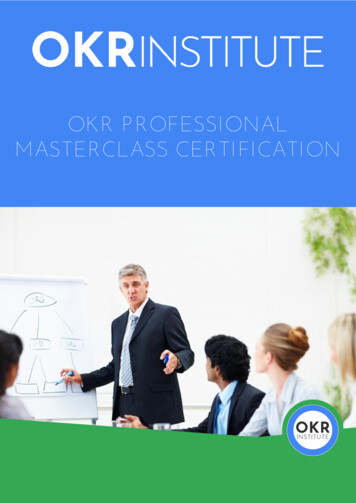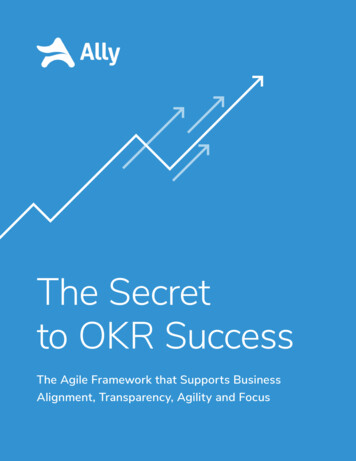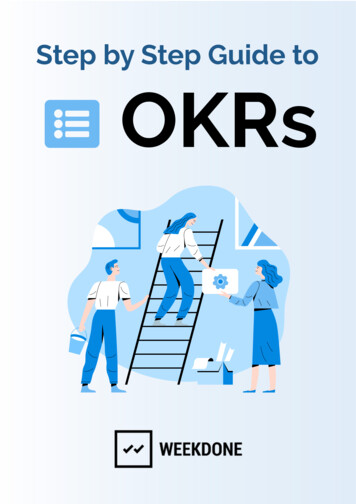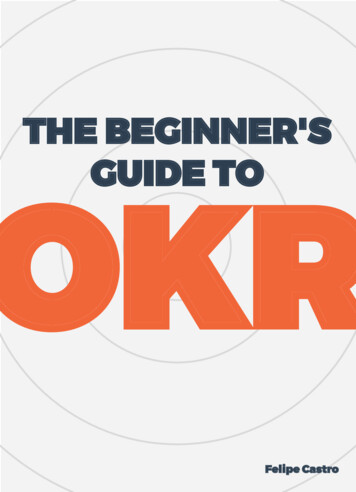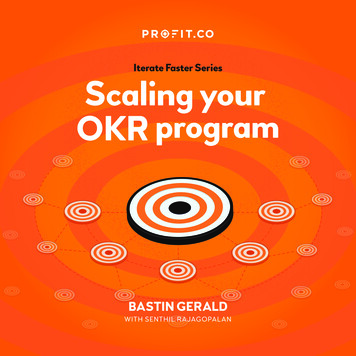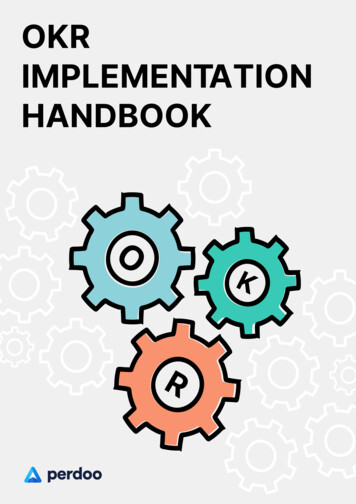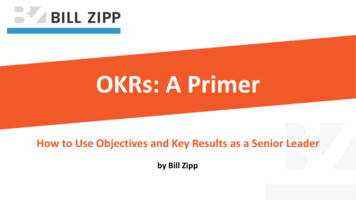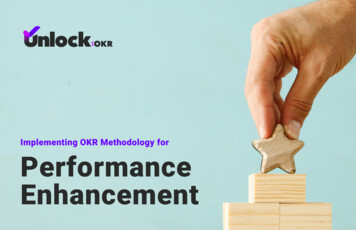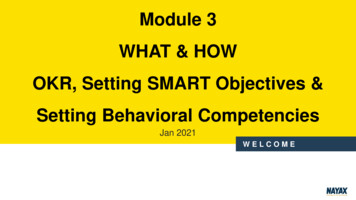
Transcription
Module 3WHAT & HOWOKR, Setting SMART Objectives &Setting Behavioral CompetenciesJan 2021WELCOME
Agenda10 MinRe cap & Setting Expectations60 MinSetting the “What”OKR & SMART Objectives10 MinCoffee Break40 MinSetting the “How”Selecting the Right Competencies
Re Cap & SettingExpectations
Our Learning JourneyOut Values, OurBehavioralCompetencies &9 Box ModelProvidingFeedback,Rating &CalibrationWHAT & HOWOKR, Setting SMARTObjectives & SettingBehavioralCompetenciesPeopleDevelopment &Coaching Skills
Your Point of ViewNow that you have completed your performance review for 2020, shareyour inputs and your learnings towards setting the “WHAT & HOW” for2021.Relate to the following: Why is it important to set clear and measurable Objectives, the “What”? What do we achieve by focusing on Behavioral Competencies, the “HOW”? How well are we setting objectives today? What are your expectations from the training?
What are your expectations from the training? “To understand the OKR model and how to setSMART objectives, to hear best practices, to betterHow well are we setting objectives today?understand how to define behaviors”. “Not so well. For 2020 I realized that employeeswere setting their own objectives while themanagers sometimes set other objectives. Someobjective” “Enhanced awareness of the behavioralcompetencies” “To make the goal setting frictionless andmeasurable by minimizing bureaucracy to theabsolute minimum” “Very poorly - mainly due to the dynamicenvironment. when company objectives changedramatically, personal objectives change with them,leading to obsolescence” “60% well - can be improved” “Well enough”
Reminder: setting up the What & HowPerformance“The What”setting Objectiveswith Key Results andmilestones“The How”selection ofexpected competenciesfrom the 6C’s modelHow things are to be accomplished supports What must be accomplished.Setting up objectives for the « The What » and « The How » is a key step in order to: Agree with the employee on a setting of his/her Objectives for the upcoming year Align each employee’s objectives on the department objectives Build the basis for Performance measuring and tracking all over the year
Setting the “What”OKR & SMART Objectives
Reminder: setting up the What & HowPerformance“The What”setting Objectiveswith Key Results andmilestones“The How”selection ofexpected competenciesfrom the 6C’s model
Why Manage by Objectives?Think of the waste from the countless decisions made every day which could have been made better if the desiredobjectives had been more apparent to the decision-maker.Research and development money is sometimes spent on projects which are later abandoned because they areinconsistent with broader corporate objectivesDouglas McGregor’s “Theory Y” stress the importance of integrating the objectives of the individual with the objectives ofthe organization.Unless we have a purpose there is no reason why individuals should tryto cooperate together at all or why anyone should try to organize them.HBR, “The Hierarchy of Objectives”Many a company is in trouble because objectives are not properlyrelated to profit objectives.
What is OKR?
What is OKR?OKR (Objectives and Key Results) is a goalOrganizationsystem that creates alignment andengagement around measurable objectives,Function/Teamstarting from the vision and strategy of theorganization, through department andPersonalindividual objectives.
Difference between KPI’s and OKR’s?If your key results and key performance indicators start to sound similar, that’s ok. Just remember that one’s anoutcome (KR) and the other a measurement (KPI).Key Results - Increase headcount by 45 percentKey Performance e Indicator – Count the number of employees hired each month compared to target
OKRs FrameworkLong TermMission &VisionMission& VisionAnnual StrategicGoal 1Annual StrategicGoal 2One YearStrategic GoalsQuarterlyObjective 1QuarterlyObjective 2QuarterlyObjective 3This QuarterObjectives &Key ResultsKey Result 1Key Result 2Initiative 1Initiatives / TasksInitiative 2Today
The Anatomy of OKR
“So that both managers andemployees will be on the samepage as to what their goals are andthat these goals would betransparent, achievable andmeasurable”.TransparencySo Why OKR?“To align with the company's goals”Focus“It allows us to focus on what isimportant and to understand what isneeded to achieve it”.AlignmentEngagement“It leads to cooperation and to abetter chance to success.”
Q3 ObjectiveO4 Objectives14,000 Units18,000 Units16,000 Units22,000 Units70% Reoccurringcustomers unit sale,from total units perquarter60% Reoccurringcustomers unit sale, fromtotal units per quarter70% Reoccurringcustomers unit sale,from total units perquarter80% Reoccurringcustomers unit sale,from total units perquarter40% new customersfrom total units perquarter40% new customersfrom total units perquarter30% new customersfrom total units perquarter20% new customersfrom total units perquarter70% Invoice from totalunits per quarter90% Invoice from totalunits per quarter70% Invoice from totalunits per quarter90% Invoice from totalunits per quarter70% Activation units,from total units perquarter70% Activation units,from total units perquarter70% Activation units,from total units perquarter70% Activation units,from total units perquarterWhere Do I Need To Go?Q2 ObjectiveHow Do I Know I am Getting There?Q1 ObjectiveObjectivesAnnual Target:70,000 unitsKey ResultsExample of OKRSales
Example of OKRCustomer SupportObjectivesInitiatives/ Tasks(Internally & Externally)X (Amount) of contentconsumed from Universityin a designated time90% Full documentation oftickets, monthly periodTake ownership of 17-21 %inbound cases per month75% open versus closed,resolved in a 30 daysperiodAverage of customersatisfaction survey of 4and above, monthlyNo escalation ticketsAverage of 24-48 Hours forresolution timeWhere Do I Need To Go?StrategicGoalsOn going learning andimprovementHow Do I Know I am Getting There?Mission& VisionImprove CustomersatisfactionObjectivesImprove SLAKey ResultsDelivery of outstandingcustomer support in anefficient mannerPresentation of 1-2 studycases per month(Internally)X (Amount) of technicalcontent development(Internally & Externally)Buddy assignment for newemployees, for a period of2 months
Example of OKRHRTalent Managementand ProcessStrategicDesign & Delivery ofGoalsModule 3 & 4 trainings,Train all managers on newapproach, processQ1 Q4and ComPro toolWhere Do I Need To Go?Performance & RecognitionHow Do I Know I am Getting There?Mission& VisionNew C&B StrategyObjectivesContinue reinforcingKey ResultsTo enable making bestdecisions on people andorganizationDevelop Model of SuccessionPlanning and TalentDevelopment linked to 9-boxQ2Q1Above 90% objectivesObjectivesforms filled in bobQ1Train EmployeesExpenditure to align withbudgetand ManagersQ3Q1-Q4Initiatives / TasksRedefine Performance process,form and toll post pilotQ2Develop new PerformanceBonus modelQ1Implement HRIS toolQ3
Rational betweenCompleted to committedstory points in sprint,lower then 10%ObjectivesMinimum of Y (Number)of post deploy issuesdetected internally, dayafter deployingIncrease by X fast trackitems during the sprintInitiatives/ TasksWhere Do I Need To Go?StrategicGoalsMinimum of x (Number)of support tickets a weekafter deployingIncrease ContentdeliveryHow Do I Know I am Getting There?Improve CustomersatisfactionObjectivesMission& VisionIncrease reliabledeploymentKey ResultsImplement newintegration and supportexisting integrationsExample of OKREngineDeveloper will resolve 23 tickets per weekQA will resolve 5-10items per week)Automation will resolve2-3 tickets per week
Golden Rules to Write S.M.A.R.T Objectives (Key Results)Specifico Is the desired achievement clearlydescribed?o Is it specific?o How will the key results lead to theexpected objective?Achievable o Is it challenging enough?o Is it realistically achievable?o Do I have the needed resources?o Can it be done in the proposed timeframe?Time-BoundMeasurable o What are the quantifiable or qualifiablemeasures?o What data can be used to measure the keyresults?o Am I measuring the outcome that drivesbusiness results (affects customersbehavior), or just the effort?Relevanto When should these key results be accomplished?o Are there any key milestones with target dates forcompletion?o When we will review the progress?o How do the objectives and key resultsdrive strategic goals? Department goals?o How does these objectives & key resultscontribute to my team/department’sobjectives?o Is the impact and benefits of the keyresults clear?
SMART Key Result ExampleSpecificMeasurableTake ownership of 17-21 %inbound cases per monthRelevantAchievableTime-Bound
1st Exercise- OKR & SMART – 20 MinThe objective of the exercise is for you to define your objectives and key results according to OKR & SMARTmodels1. You will be divided to pairs and work in breakout rooms2. Individually, define one objective for you for this year and 2-3 key results derived from this objective, according to theOKR and SMART objectives you have just learned. Assist with the performance management guidebook -5 Min3. Challenge each other via the SMART questions: Make sure the key results are according to the SMART method - 15 Min
Exercise 1 – Re Cap on the WHATShare your experience, what worked well andwhat didn’t?
Optimal Zone of DifficultyThe human brain loves achallenge, but only if it is within anoptimal zone of difficulty.Humans experience peaksmotivation when working ontasks that are right on the edgeof their current abilities. Nottoo hard. Not too easy. Justright
Objectives- bob formImprove SLA1.2.30%3.X (Amount) of content consumed fromUniversity in a designated time90% Full documentation of tickets,monthly periodTake ownership of 17-21 % inboundcases per month
Setting the “How”Selecting the RightCompetencies
Reminder: setting up the What & HowPerformance“The What”setting Objectiveswith Key Results andmilestones“The How”selection ofexpected competenciesfrom the 6C’s model
What Do We Achieve By Focusing on BehavioralCompetencies , “HOW”?“The how is important for sustainability - we can't achieveobjectives if our behaviors are counterproductive”“A skill set to enable us to meet objectives”“That the goals set are achieved within company definesparameters and values”“Some goals are less measurable in numbers but more,measurable in "how". In addition, the "how" is as important asthe "what" to encourage positive atmosphere (internally andexternally) as well as cultivate a good company culture whichallows for fast growth in today's economy.”
Why are competencies keyto deliver performance?The cake analogyTwo cooks are in a friend’s kitchen, it is the first time they have usedthat kitchen and they want to bake a cake for dinner for theirfriends and family.Their priority is then: bake a cake, by tonight, by choosing therecipe, using an unknown kitchen and purchasing the ingredients.The two cooks bake the cake in two different ways.Identify which competencies the cooks used, and how they appliedthem, to achieve the result.
Why are Competencies Key to Deliver Performance? “The Cake Analogy”Cook #1: Assumes everybody loves chocolate, he will bake a chocolate cake He finds recipe in a book found on a shelf in the house He buys all the ingredients at first, in the same place He mixes them all together at the same time He keeps the cake in the oven for one hour, as it is written on the recipeResult: Slightly overcooked cake, with lumps for dessert at dinner. But still a cake.What competencies were needed to achieve the result? Did the cook apply them in the right way?
Why are Competencies Key to Deliver Performance? “The Cake Analogy”Cook #2: Asks friends and family about their favorite cake: chocolate cake Seeks advice from others to find the best chocolate cake recipe Carefully selects the ingredients, looking for the best value for money Slowly melts the chocolate with the butter, in a water-bath When chocolate is melted, adds the sugar and then the flour, in stages to avoid lumps Bakes it in the oven, checking progress with a knife every 10 minutesResult: Tasty cake, good texture on the outside and melting inside, for dessert at dinnerWhat competencies were needed to achieve the result? Did the cook apply them in the right way?
Why are Competencies Key to Deliver Performance? “The Cake Analogy” In both cases, the priority is met: “bake a cake, by tonight, by choosingthe recipe, using an unknown kitchen and purchasing the ingredients”. What changes is “the How”, the competencies mobilized in order to bake the cake. Performance is clearlybetter in the 2nd case, not only because the cake is better, but also because it perfectly suits customers’taste and is cheaper to produce than the 1st cake. By mobilizing the right competencies at the right moment, a better performance is achieved: better resultwith less expensive resources.
Operational Guide for Selecting Competencies0201Ask employees to prioritize thecompetencies they considerimportant for their job over thecoming year. Take their viewinto account.0403List the employee’s job activities /requirementsReview the employee’spriorities (the What)0506Identify the behaviors that willhelp the employee deliver theexpected results (the What)during the coming yearConsider to which competenciesthose behaviors are related.You may select 2,3,4, competencies from the 6C’s07Consider any evolutions totheir role requirements inthe coming year:e.g.: new technologies,involvement in a project, Communicate selected competencies to yourdirect report: explain how you selected them ask her/him to repeat what she/he understoodfrom each competency ask for examples of behaviors related to thatcompetency Make sure you are on the same page bystating clearly to what extent you expect theemployee to develop or to apply thecompetency
Sample questions to ask yourself when selecting competenciesIn the previous year,which competenciesdid the employeeapply well indelivering theirresults?You may choose to selectthose competencies again.Encouraging the employeeto reinforce the behaviorsand seek to leverage thecompetency in order tomaximize performance.Can the employeeachieve the objectiveswith the competencieshe/she currentlymasters?If not, focus on the gapswhen selectingcompetencies.You may also considercompetencies whichsupport the employee’saspirations & individualdevelopment planTo whichcompetencies are thedesired behaviorslinked?What could theemployee do better?List the behaviors he/shecould improve.Illustrate how that couldimprove, providingexamples.
Sample questions to ask yourself when selecting competenciesWhichcompetenciesneed to be developed inthe coming monthsbecause of a change inthe job-relatedactivities?Consider job relatedactivities that you anticipatemay change in the nearfutureIs there a gap betweenwhat you expect fromthe employee’scompetencies andhis/her current level?If so, consider prioritizingfewer competencies., tocreate focus.Clearly state the gap andexpectation.Reassure the employee byexplaining how you will helptheir development. 38
2ND Exercise- Setting the “How” ,Selecting the Right Competencies– 15 MinThe Objective of this exercise is to identify the relevant 6C’s competencies to Danny’s and Noa’s jobfor 20211. In a few minutes you will be divided to groups and work in breakout rooms2. Read the exercise3. Discuss and prioritize which Behavioral Competencies both Noa & Danny should focus on todeliver performance in 2021.
Meet Danny & NoaYou are Kate, Danny’s and Noa’s manager.Both joined Nayax 2 years ago and are brand managers, responsible for the launch of Nayax’s brands in the past year.Both have met their priorities for 2020, each achieving a 35% market share to their brand.2021 Objective and KR:To grow average market shares to 45 % for each brand by the end of 2021Behavioral Competencies (How) in 2020:Behavioral Competencies (How) in 2020: During the past year, Danny took full responsibility for his assignments.assignments. When facing a challenge, he worked to find aproper solution. One of things that he exceeded in was hisDuring the past year, Noa took full responsibility for her Noa is focused on customers needs and tries to see differentcontinuance drive to think different and to find new ways ofperspectives, including her teams, in order to deliver theworking that will improve his results.best solution for the customer. One of the feedbacks given from his peers was that Danny is However, Noa works with a structured plan and when facingworking silo and doesn’t take under consideration othera change, she finds it difficult to adjust accordingly. You’veopinions, including the customers and he relays more on hisheld several conversations with her during the year, but youassumptions.saw little progress.
What are your maintakeaways?
2020 Year- End Review TimelineEmployeesYear-End Reviewself assessment 2020(How & What)Deadline to submit selfassessment in systemDec 7*Rating proposals to be calibrated, do not communicate toemployee before final approval**Propose in system to be approved by N 1, HR, CEO/CTOFinalize 2021 objectives inthe system(How & What)Jan 31 Feb 16Confirm receipt ofrating in the systemMar 31Bob systemopensNov 17NovSelf orm 2020 Year – End Reviewand set objectives for 2021Deadline to propose 9 Box rating inthe system(What & How)Jan 7* Jan 14thMarFebSubmit merit proposals in thesystem **Feb 1 – 5Calibrationand ApprovalCommunicationCommunicateReceive approval fordecisions toperformance rating &employees in personmeritSend communicationSystem locksletter (BoB)performance ratingsMar 31Feb 28
Thank you
1st Exercise- OKR & SMART – 20 Min The objective of the exercise is for you to define your objectives and key results according to OKR & SMART models 1. You will be divided to pairs and work in breakout rooms 2. Individually, define one objective for you for this year and 2-3
